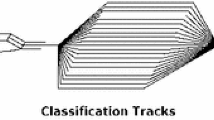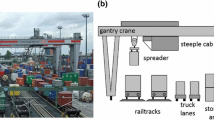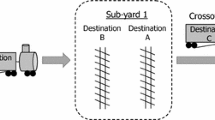Abstract
In a modern rail–rail transshipment yard huge gantry cranes transship containers between different freight trains, so that hub-and-spoke railway systems are enabled. In this context, we consider the transshipment yard scheduling problem (TYSP) where trains have to be assigned to bundles, which jointly enter and leave the yard. The objective is to minimize split moves and revisits. Split moves appear whenever containers have to be exchanged between trains of different bundles, whereas revisits occur if a train has to enter the yard twice, because some container dedicated to this train was not available during its first visit. We extend the basic TYSP, so that additional real-world requirements of modern rail–rail yards, e.g., the one currently constructed in Hannover-Lehrte, are considered. We provide complexity proofs for different problem settings and present several heuristic procedures as well as one exact algorithm. The paper concludes with computational results showing the efficiency of the proposed algorithms.
Similar content being viewed by others
Explore related subjects
Discover the latest articles, news and stories from top researchers in related subjects.References
Alicke, K. (2002). Modeling and optimization of the intermodal terminal mega hub. OR Spectrum, 24, 1–17.
Alicke, K., & Arnold, D. (1998). Modellierung und Optimierung von mehrstufigen Umschlagsystemen. Fördern und Heben, 8, 769–772.
Ballis, A., & Golias, J. (2002). Comparative evaluation of existing and innovative rail–road freight transport terminals. Transportation Research Part A: Policy and Practice, 36, 593–611.
Blasum, U., Bussieck, M., Hochstättler, W., Moll, C., Scheel, H.-H., & Winter, T. (1999). Scheduling trams in the morning. Mathematical Methods of Operations Research, 49, 137–148.
Bontekoning, Y., Macharis, C., & Trip, J. (2004). Is a new applied transportation research field emerging? A review of intermodal rail-truck freight transport literature. Transportation Research Part A: Policy and Practice, 38, 1–24.
Bostel, N., & Dejax, P. (1998). Models and algorithms for container allocation problems on trains in a rapid transshipment shunting yard. Transportation Science, 32, 370–379.
Boysen, N., & Fliedner, M. (2010). Determining crane areas in intermodal transshipment yards: The yard partition problem. European Journal of Operational Research, 204, 336–342.
Boysen, N., Jaehn, F., & Pesch, E. (2010a). Scheduling freight trains in rail–rail transshipment yards, Transportation Science, to apppear
Boysen, N., Fliedner, M., & Kellner, M. (2010b). Determining fixed crane areas in rail–rail transshipment yards. Transportation Research Part E, 46, 1005–1016.
Cordeau, J.-F., Toth, P., & Vigo, D. (1998). A survey of optimization models for train routing and scheduling. Transportation Science, 32, 380–404.
Corry, P., & Kozan, E. (2008). Optimised loading patterns for intermodal trains. OR Spectrum, 30, 721–750.
Crainic, T., & Kim, K. (2007). Intermodal transport. In C. Barnhart & G. Laporte (Eds.), Transportation: Vol. 14. Handbooks in operations research and management science (pp. 467–538). Amsterdam: North-Holland.
Dahlhaus, E., Horak, P., Miller, M., & Ryan, J. (2000). Optimised loading patterns for intermodal trains. Discrete Applied Mathematics, 103, 41–54.
EU (2007). Mitteilung der Kommission an den Rat und das europäische Parlament: Aufbau eines vorrangig für den Güterverkehr bestimmten Schienennetzes.
Feo, T., Goldschmidt, O., & Khellaf, M. (1992). One-half approximation algorithms for the k-partition problem. Operations Research, 40, 170–173.
Freling, R., Lentink, R., Kroon, L., & Huisman, D. (2005). Shunting of passenger train units in a railway station. Transportation Science, 39, 261–272.
Garey, M., & Johnson, D. (1979). Computers and intractability: A guide to the theory of NP-completeness. New York: Freeman.
He, S., Song, R., & Chaudhry, S. (2000). Fuzzy dispatching model and genetic algorithms for railyards operations. European Journal of Operational Research, 124, 307–331.
Kellner, M., Boysen, N., & Fliedner, M. (2010). How to park freight trains on rail–rail transshipment yards: The train location problem, submitted.
Lim, A., Rodrigues, B., & Xu, Z. (2007). A m-parallel crane scheduling problem with a non-crossing constraint. Naval Research Logistics, 54, 115–127.
Macharis, C., & Bontekoning, Y. (2004). Opportunities for or in intermodal freight transport research: A review. European Journal of Operational Research, 153, 400–416.
Meyer, P. (1999). Entwicklung eines Simulationsprogramms für Umschlagterminals des Kombinierten Verkehrs. Aachen: Shaker Verlag.
Moccia, L., Cordeau, J., Gaudioso, M., & Laporte, G. (2006). A branch-and-cut algorithm for the quay crane scheduling problem in a container terminal. Naval Research Logistics, 53, 45–59.
Papadimitriou, C., & Steiglitz, K. (1982). Combinatorial optimization: Algorithms and Complexity. Prentice-Hall: Englewood Cliffs.
Pesch, E., & Glover, F. (1997). TSP ejection chains. Discrete Applied Mathematics, 76, 165–181.
Rotter, H. (2004). New operating concepts for intermodal transport: The mega hub in Hanover/Lehrte in Germany. Transportation Planning and Technology, 27, 347–365.
Sammarra, M., Cordeau, J., Laporte, G., & Monaco, M. (2007). A tabu search heuristic for the quay crane scheduling problem. Journal of Scheduling, 10, 327–336.
Tanaev, V. S., Gordon, V. S., & Shafransky, Y. M. (1994). Scheduling theory. Single-stage systems. Kluwer: Dordrecht.
Wiegmans, B., Stekelenburg, D., Versteegt, C., & Bontekoning, Y. (2007). Modeling rail–rail exchange operations: An analysis of conventional and new-generation terminals. Transportation Journal, 46, 5–20.
Winter, T., & Zimmermann, U. (2000). Real-time dispatch of trams in storage yards. Annals of Operations Research, 96, 287–315.
Zhu, Y., & Lim, A. (2006). Crane scheduling with non-crossing constraints. Journal of Operational Research Society, 57, 1464–1471.
Author information
Authors and Affiliations
Corresponding author
Rights and permissions
About this article
Cite this article
Boysen, N., Jaehn, F. & Pesch, E. New bounds and algorithms for the transshipment yard scheduling problem. J Sched 15, 499–511 (2012). https://doi.org/10.1007/s10951-010-0200-2
Published:
Issue Date:
DOI: https://doi.org/10.1007/s10951-010-0200-2




